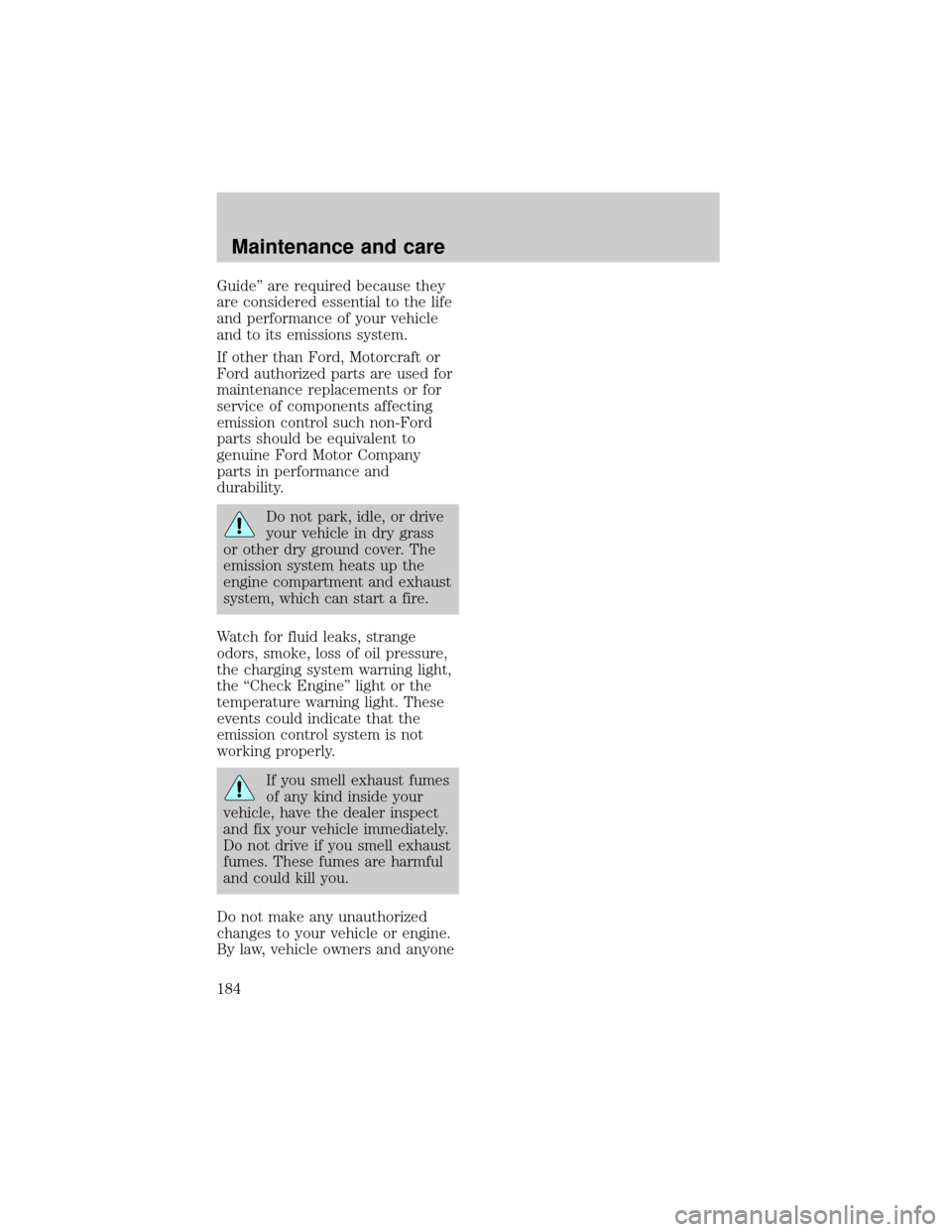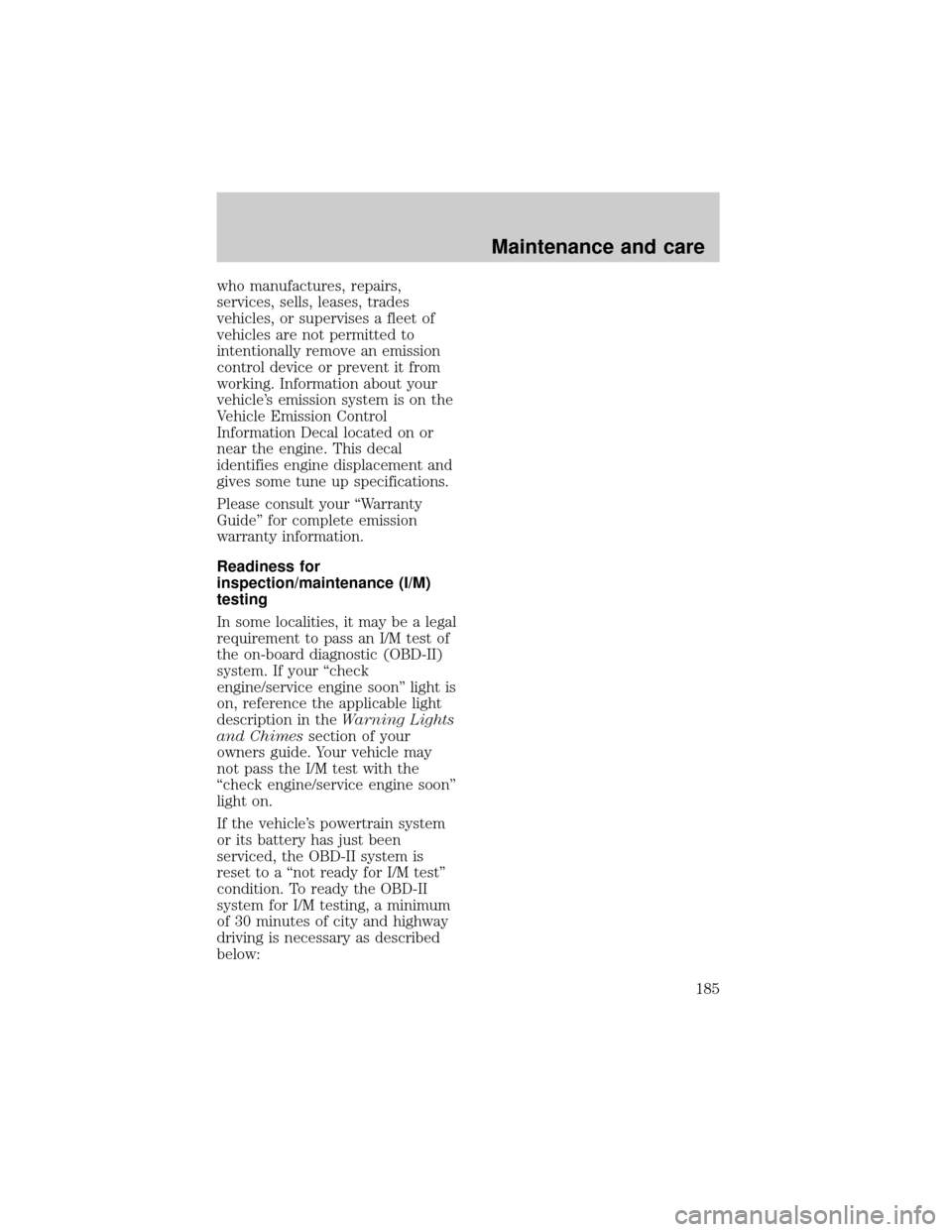Page 163 of 216
no air conditioning capability.
Continued operation will increase
engine temperature and cause the
engine to completely shut down.
The vehicle will coast to a stop.
As the engine temperature cools,
the engine may be re-started. Take
your vehicle to a service facility as
soon as possible to minimize
engine damage.
When fail-safe mode is
activated
²Pull off the road as soon as
possible.
²Immediately turn the engine off
to prevent severe engine
damage.
²Wait for the engine to cool.
²Check the coolant level.
CHECKING AND ADDING
POWER STEERING FLUID
Check the power steering fluid at
least twice a year. If adding fluid is
necessary, use only MERCONt
ATF power steering fluid.
1. Start the engine and let it run
until it reaches normal operating
temperature (the engine coolant
temperature gauge will be near the
center of the NORMAL band).
Maintenance and care
163
Page 164 of 216
2. While the engine idles, turn the
steering wheel left and right
several times.
3. Turn the engine off.
4. Check the fluid level in the
reservoir. It should be between the
MIN and MAX lines. Do not add
fluid if the level is in this range.
5. If the fluid is low, add fluid in
small amounts, continuously
checking the level until it reaches
the range between the MIN and
MAX lines. Be sure to put the cap
back on the reservoir.
TRANSMISSION FLUID
Checking and adding automatic
transmission fluid
Follow the scheduled service
intervals outlined in the ªService
Guide.º
Before adding any fluid, make sure
the correct type is used. The type
of fluid used is normally indicated
on the dipstick and/or dipstick
handle and also in theLubricant
specificationssection in the
MAX
MIN
MAX
MIN
Maintenance and care
164
Page 166 of 216
![FORD EXPEDITION 1998 1.G Owners Manual The transmission fluid should be in
this range if at room temperature
(10ÉC-35ÉC [50ÉF-95ÉF]) (see
figure to the right).
If your vehicle has been operated
for an extended period at high
speeds, in FORD EXPEDITION 1998 1.G Owners Manual The transmission fluid should be in
this range if at room temperature
(10ÉC-35ÉC [50ÉF-95ÉF]) (see
figure to the right).
If your vehicle has been operated
for an extended period at high
speeds, in](/manual-img/11/4906/w960_4906-165.png)
The transmission fluid should be in
this range if at room temperature
(10ÉC-35ÉC [50ÉF-95ÉF]) (see
figure to the right).
If your vehicle has been operated
for an extended period at high
speeds, in city traffic during hot
weather or pulling a trailer, the
vehicle should be turned off for
about 30 minutes to allow the fluid
to cool before checking.
1. Park the vehicle on a level
surface and engage the parking
brake.
2. With the parking brake engaged
and your foot on the brake pedal,
start the engine and move the
gearshift lever through all of the
gear ranges. Allow sufficient time
for each gear to engage.
3. Latch the gearshift lever in P
(Park) and leave the engine
running.
4. Remove the dipstick, wiping it
clean with a clean, dry lint free
rag.
5. Install the dipstick making sure
it is fully seated in the filler tube.
6. Remove the dipstick and inspect
the fluid level. The fluid level
should be in the crosshatched area
on the dipstick.DON'T ADD IF IN CROSSHATCHED AREA • CHECK WHEN HOT IDLING IN PARK
ADD COLD HOT DO NOT ADD
P R N D 2 1
Maintenance and care
166
Page 182 of 216
![FORD EXPEDITION 1998 1.G Owners Manual ²To help reduce early nozzle shut
off and fuel spillage, park your
vehicle so the fuel filler door is
level.
²Avoid excessively fast fuel
dispensing rates (over 38 L
[10 gallons] per minute).
²If y FORD EXPEDITION 1998 1.G Owners Manual ²To help reduce early nozzle shut
off and fuel spillage, park your
vehicle so the fuel filler door is
level.
²Avoid excessively fast fuel
dispensing rates (over 38 L
[10 gallons] per minute).
²If y](/manual-img/11/4906/w960_4906-181.png)
²To help reduce early nozzle shut
off and fuel spillage, park your
vehicle so the fuel filler door is
level.
²Avoid excessively fast fuel
dispensing rates (over 38 L
[10 gallons] per minute).
²If you spill fuel on the body of
your vehicle, clean it off
immediately. The fuel may dull
or soften the paint if it is not
washed off promptly.
²To replace the fuel cap, align
the tabs on the cap with the
notches on the fuel filler pipe.
Turn it clockwise until it stops.
²Push the fuel door closed.
If the check engine warning light
illuminates and remains illuminated
while the engine is started, the
fuel cap may not be properly
seated. Turn off the engine,
remove the fuel cap and replace it,
being sure to align the cap
properly.
If the cap is lost, replace it with an
authorized Motorcraft or equivalent
part.
Calculating fuel economy
To accurately calculate your
vehicle's fuel economy:
1. Fill the tank completely and
record the initial odometer
reading.
2. Each time you fill the tank,
record the amount of fuel added
(in liters or gallons).
Maintenance and care
182
Page 184 of 216

Guideº are required because they
are considered essential to the life
and performance of your vehicle
and to its emissions system.
If other than Ford, Motorcraft or
Ford authorized parts are used for
maintenance replacements or for
service of components affecting
emission control such non-Ford
parts should be equivalent to
genuine Ford Motor Company
parts in performance and
durability.
Do not park, idle, or drive
your vehicle in dry grass
or other dry ground cover. The
emission system heats up the
engine compartment and exhaust
system, which can start a fire.
Watch for fluid leaks, strange
odors, smoke, loss of oil pressure,
the charging system warning light,
the ªCheck Engineº light or the
temperature warning light. These
events could indicate that the
emission control system is not
working properly.
If you smell exhaust fumes
of any kind inside your
vehicle, have the dealer inspect
and fix your vehicle immediately.
Do not drive if you smell exhaust
fumes. These fumes are harmful
and could kill you.
Do not make any unauthorized
changes to your vehicle or engine.
By law, vehicle owners and anyone
Maintenance and care
184
Page 185 of 216

who manufactures, repairs,
services, sells, leases, trades
vehicles, or supervises a fleet of
vehicles are not permitted to
intentionally remove an emission
control device or prevent it from
working. Information about your
vehicle's emission system is on the
Vehicle Emission Control
Information Decal located on or
near the engine. This decal
identifies engine displacement and
gives some tune up specifications.
Please consult your ªWarranty
Guideº for complete emission
warranty information.
Readiness for
inspection/maintenance (I/M)
testing
In some localities, it may be a legal
requirement to pass an I/M test of
the on-board diagnostic (OBD-II)
system. If your ªcheck
engine/service engine soonº light is
on, reference the applicable light
description in theWarning Lights
and Chimessection of your
owners guide. Your vehicle may
not pass the I/M test with the
ªcheck engine/service engine soonº
light on.
If the vehicle's powertrain system
or its battery has just been
serviced, the OBD-II system is
reset to a ªnot ready for I/M testº
condition. To ready the OBD-II
system for I/M testing, a minimum
of 30 minutes of city and highway
driving is necessary as described
below:
Maintenance and care
185
Page 186 of 216
²First, at least 10 minutes of
driving on an expressway or
highway.
²Next, at least 20 minutes driving
in stop and go, city type traffic
with at least four idle periods.
Allow the vehicle to sit for at least
eight hours without starting the
engine. Then, start the engine and
complete the above driving cycle.
The engine must warm up to its
normal operating temperature.
Once started, do not turn off the
engine until the above driving
cycle is complete.
EXTERIOR BULBS
Replacing exterior bulbs
Check the operation of the
following lamps frequently:
²headlamps
²foglamps
²high-mount brakelamp
²brakelamps
²parking lamps
²turn signals
²license plate lamp
²tail lamps
²back-up lamps
Do not remove lamp bulbs unless
they can be replaced immediately
with new ones. If a bulb is
removed for an extended period of
time, contaminants may enter the
lamp housings and affect lamp
performance.
Maintenance and care
186
Page 201 of 216

Fluid Ford Part
NameApplication
Capacity
Windshield
washer fluidUltra-Clear
Windshield
ConcentrateAll
4.1L
(4.5 quarts)
Engine coolant Ford Premium
Cooling System
Fluid4.6L engine with
2 row radiator17.9 L
(19.9 quarts)
4.6L engine with
1 row radiator17.0L
(18.0 quarts)
5.4L engine 19.7L
(20.8 quarts)
Front axle fluid Motorcraft SAE
75W90 Axle
Lubricant4 x 4 vehicles
1.8-2.0L
(3.5-3.7 pints)
Rear axle fluid
1Motorcraft SAE
75W140
Synthetic Rear
Axle LubricantAll
2.9-3.1L
(5.5-5.8 pints)
1Your vehicle's rear axle is
equipped with synthetic rear axle
lubricant. Rear axles containing
synthetic lubricant are lubricated
for life. These lubricants are not to
be checked or changed unless a
leak is suspected, service required
or the axle has been submerged in
water. The axle lubricant should be
changed any time the axle has
been submerged in water. Add 118
ml (4 oz.) of additive friction
modifier C8AZ-19B546±A, Ford
specification EST-M2C118±A
whenever the fluid is changed.
Service refill capacities are
determined by filling the rear axle
6 mm to 14 mm (1/4 inch to 9/16
Capacities and specifications
201